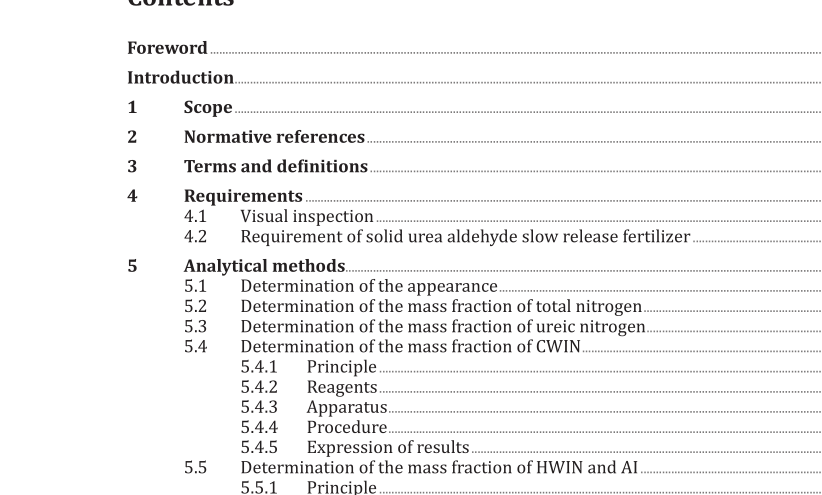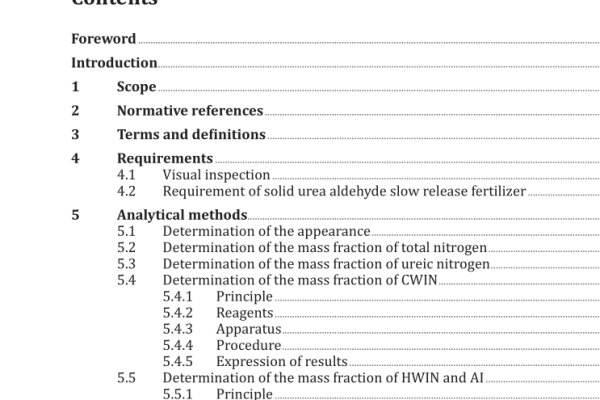ISO 19670:2017 pdf download – Fertilizers and soil conditioners — Solid urea aldehyde slow release fertilizer — General requirements.
3.2 cold water insoluble nitrogen CWIN insoluble nitrogen fractions in urea formaldehyde or methylene urea products that are insoluble in phosphate buffer solution (pH 7,5) or distilled water at 25 °C during a 15 min period 3.3 cold water soluble nitrogen CWSN soluble nitrogen fractions in urea formaldehyde or methylene urea products that are soluble in phosphate buffer solution (pH 7,5) or distilled water at 25 °C during a 15 min period Note 1 to entry: CWSN = Total nitrogen – CWIN 3.4 hot water insoluble nitrogen HWIN insoluble nitrogen fractions in urea formaldehyde or methylene urea products that are insoluble in phosphate buffer solution (pH 7,5) at 100 °C during a 30 min period 3.5 hot water soluble nitrogen HWSN soluble nitrogen fractions in urea formaldehyde or methylene urea products that are soluble in phosphate buffer solution (pH 7,5) at 100 °C during a 30 min period Note 1 to entry: HWSN = Total nitrogen – HWIN 3.6 hot water soluble nitrogen only HWSN only soluble nitrogen fractions in urea formaldehyde or methylene urea products that are soluble in phosphate buffer solution (pH 7,5) at 100 °C during a 30 min period and insoluble in phosphate buffer solution (pH 7,5) at 25 °C during a 15 min period Note 1 to entry: HWSN only = HWSN – CWSN = CWIN – HWIN
5.6 Determination of the mass fraction of nitrogen from IBDU and CDU It shall be determined in accordance with ISO 25705:2016, method A or ISO 19746. 6 Sampling and preparation of test sample 6.1 Sampling method 6.1.1 Products in bags Carry out the sampling operation by following the procedure described in ISO 8633. 6.1.2 Products in bulk Carry out the sampling operation by following the procedure described in ISO 8633. 6.2 Reduction of samples Mix all the increments (collected as in 6.1) uniformly and promptly to form a single aggregate sample using a device or by hand. The aggregate sample is reduced to about 1 kg according to the procedure in ISO 7742. Next, divide into two parts for final laboratory samples. The two laboratory samples are put into two clean and dry glass or plastic containers or any other inert material of adequate resistance capable of maintaining the sample in its original condition. The containers shall be fitted with airtight closures. Carry out all the operations described above as rapidly as possible to avoid loss or gain of moisture. Each container shall be secured and sealed following the instruction given in ISO 7410. Each laboratory sample shall be labelled following the instructions given in ISO 7410. The label shall, at minimum, carry the following information: a) the name of manufacturer; b) the name of product; c) the manufacturer’s reference and batch number or production date (if available); d) the lot size; e) the date of sampling; f) the place of sampling; g) the signature of the sampler; h) the signature and name of the person or his representative on whose premises the sample was taken. One of the containers is used for further quality analysis, while the other is kept for additional analysis in 6 mos.
ISO 19670:2017 pdf download – Fertilizers and soil conditioners — Solid urea aldehyde slow release fertilizer — General requirements






